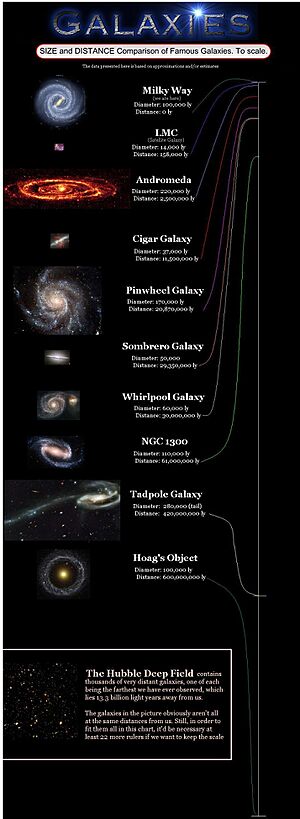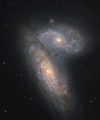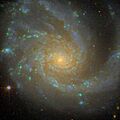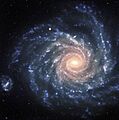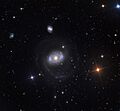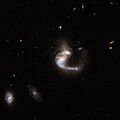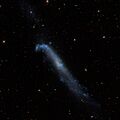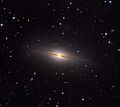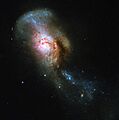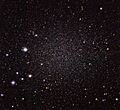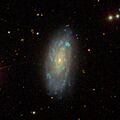List of galaxies facts for kids
Galaxies are huge groups of stars, dust, and gas all held together by gravity. Our own home, the Solar System, is part of a galaxy called the Milky Way.
Scientists believe there are about 51 galaxies in our local neighborhood, called the Local Group. In a bigger area called the Local Supercluster, there are around 100,000 galaxies. And in the entire observable universe, there might be as many as 100 billion galaxies!
For a long time, people didn't know that galaxies were separate from other cloudy objects in space, called nebulae. But in the 1920s, scientists figured out that galaxies are indeed their own huge star systems.
To keep track of all these galaxies, astronomers create big lists. In the 1960s, some of the first major lists were made, like the Catalogue of Galaxies and Clusters of Galaxies, which had almost 30,000 entries. Today, projects like Galaxy Zoo let people help classify over a million galaxy images!
Galaxies don't have simple names like "Galaxy One." Instead, they are usually named after the sky survey or project that found them. For example, you might see names like HUDF, SDSS, or NGC.
Contents
Famous Galaxies and Their Names
Many galaxies are known by special names, not just catalog numbers. These names often come from how they look or who discovered them.
| Image | Galaxy | Constellation | Why it's named that | Cool facts |
|---|---|---|---|---|
 |
Andromeda Galaxy | Andromeda | Named after the constellation it's in. | This is the closest big galaxy to our Milky Way. It's expected to crash into the Milky Way in about 4.5 billion years! They will merge into a new galaxy called Milkdromeda. |
 |
Antennae Galaxies | Corvus | They look like an insect's antennae. | These are two galaxies that are currently crashing into each other. |
 |
Backward Galaxy | Centaurus | It seems to spin backwards, with its spiral arms pointing in the direction of rotation. | |
 |
Bear Paw Galaxy | Lynx | It looks like a bear's claw. | Also called "Bear Claw Galaxy." |
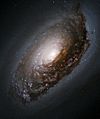 |
Black Eye Galaxy | Coma Berenices | It has a dark band of dust that looks like a "black eye" in front of its bright center. | Also known as "Sleeping Beauty Galaxy." |
 |
Bode's Galaxy | Ursa Major | Named after Johann Elert Bode, who found it in 1774. | This is the largest galaxy in the M81 Group. It has a supermassive black hole that's 70 million times bigger than our Sun! |
 |
Cartwheel Galaxy | Sculptor | It looks like a spoked cartwheel. | This is the biggest galaxy in its group, which has four spiral galaxies. |
 |
Cigar Galaxy | Ursa Major | It looks like a cigar. | Also known as Messier 82 or M82. |
 |
Circinus Galaxy | Circinus | Named after the Circinus constellation where it is found. | |
 |
Comet Galaxy | Sculptor | It looks like a comet with a long tail. | Its comet-like shape is caused by a nearby galaxy cluster pulling on it. |
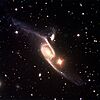 |
Condor Galaxy | Pavo | Named after a condor, a very large bird. | This is the largest known spiral galaxy, stretching over 665,300 light-years wide. A smaller galaxy is pulling on its shape. |
 |
Cosmos Redshift 7 | Sextans | Its name comes from a measurement called Redshift (z) which is almost 7. | This galaxy is one of the brightest and most distant galaxies ever found. It might contain some of the very first stars that created the chemical elements needed for planets and life. |
 |
Fireworks Galaxy | Cygnus and Cepheus | It looks bright and spotty, like fireworks. | This is a very active galaxy where many new stars are forming. |
 |
Hoag's Object | Serpens Caput | Named after Art Hoag, who discovered this ring galaxy. | This galaxy is a special type of ring galaxy. |
 |
Large Magellanic Cloud | Dorado/Mensa | Named after Ferdinand Magellan, a famous explorer. | This is the fourth-largest galaxy in the Local Group. It's a close neighbor to our Milky Way. |
 |
Malin 1 | Coma Berenices | Discovered and named by David Malin. | This is a very spread-out galaxy, making it hard to see. |
 |
Mice Galaxies | Coma Berenices | They look like two mice with long tails. | These are two galaxies that are crashing into each other. |
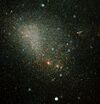 |
Small Magellanic Cloud | Tucana | Named after Ferdinand Magellan. | This is another close neighbor to our Milky Way, forming a pair with the Large Magellanic Cloud. |
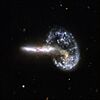 |
Mayall's Object | Ursa Major | Named after Nicholas Mayall, who discovered it. | This strange object is likely two galaxies crashing into each other. |
 |
Milky Way | Sagittarius (center) | It looks like a band of milky light across the night sky from Earth. | This is our home galaxy! It contains our Sun and Solar System, including Earth. |
 |
Needle Galaxy | Coma Berenices | It looks long and thin, like a needle. | Also known as Caldwell 38. |
| Peekaboo Galaxy | Hydra | It was hidden behind a bright star and only became visible when the star moved away. | This galaxy is very old and has very few heavy elements, making it special. | |
 |
Pinwheel Galaxy | Ursa Major | It looks like a pinwheel (toy). | Also known as Messier 101 or M101. |
| Sculptor Galaxy | Sculptor | Named after its location in the Sculptor constellation. It's also called the Silver Dollar or Silver Coin Galaxy because it looks light and round. | Also known as the Silver Coin, Silver Dollar Galaxy or Caldwell 65. | |
 |
Sombrero Galaxy | Virgo | It looks like a sombrero hat. | Also known as Messier Object 104 or M104. |
 |
Southern Pinwheel Galaxy | Hydra | It looks like the Pinwheel Galaxy but is in the southern part of the sky. | |
 |
Sunflower Galaxy | Canes Venatici | It looks like a sunflower. | |
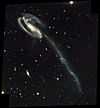 |
Tadpole Galaxy | Draco | It looks like a tadpole with a long tail. | Its tail was formed when another galaxy pulled on it during a close encounter. |
| Triangulum Galaxy | Triangulum | Named after its location in the Triangulum constellation. | ||
| Whirlpool Galaxy | Canes Venatici | It looks like a whirlpool because of how its arms are twisted. |
Important Discoveries About Galaxies
Scientists have made many exciting discoveries about galaxies over time. Here are some of the firsts:
| First | Galaxy | Constellation | Year | What was special about it |
|---|---|---|---|---|
| First spiral galaxy | Whirlpool galaxy | Canes Venatici | 1845 | Lord William Parsons was the first to see its spiral shape, even though he didn't know it was a separate galaxy yet. |
| Idea of a galaxy | Milky Way Galaxy and Andromeda galaxy | Sagittarius (center) and Andromeda | 1923 | Edwin Hubble proved that the Milky Way and the Andromeda nebula were two separate galaxies, not just clouds within our own. |
| First radio galaxy | Cygnus A | Cygnus | 1951 | This was the first "radio star" (a strong source of radio waves) that was identified as a distant galaxy. |
| First quasar | 3C273 | Virgo | 1962 | 3C273 was the first quasar whose distance could be measured. Quasars are super bright centers of galaxies. |
| First super-fast galactic jet | 3C279 | Virgo | 1971 | This galaxy shoots out a jet of material that appears to move faster than light (though it's an optical illusion). |
| First low-surface-brightness galaxy | Malin 1 | Coma Berenices | 1986 | This was the first confirmed galaxy that is very spread out and faint, making it hard to see. |
Closest and Farthest Galaxies
Scientists are always looking for the closest and most distant galaxies to learn more about the universe.
Closest Galaxies
| Rank | Galaxy | Distance | Notes |
|---|---|---|---|
| 1 | Milky Way Galaxy | 0 | This is our home galaxy, where Earth is! |
| 2 | Canis Major Dwarf | 0.025 million light-years | |
| 3 | Virgo Stellar Stream | 0.030 million light-years | |
| 4 | Sagittarius Dwarf Spheroidal Galaxy | 0.081 million light-years | |
| 5 | Large Magellanic Cloud | 0.163 million light-years | This is the largest satellite galaxy of the Milky Way. |
| Type | Galaxy | Year found | Distance | Notes |
|---|---|---|---|---|
| Nearest galaxy to the Milky Way | Sagittarius Dwarf Spheroidal Galaxy | 1994 | 0.070 million light-years | This is the closest galaxy that everyone agrees is a galaxy. |
| Nearest major galaxy to the Milky Way | Andromeda Galaxy | always | 2.54 million light-years | It was first identified as a separate galaxy in 1923. |
Most Distant Galaxies
Scientists use something called "redshift" to measure how far away very distant objects are. The higher the redshift number (z), the farther away the object is.
| Type | Galaxy | Year found | Redshift | Notes |
|---|---|---|---|---|
| Most distant galaxy confirmed | JADES-GS-z13-0 | 2022 | z=13.2 | This is the most distant galaxy confirmed by detailed measurements as of late 2022. Its light has traveled for 13.6 billion years to reach us! |
| Most distant quasar | QSO J0313–1806 | 2021 | z=7.64 | This is the most distant known quasar as of early 2021. |
| Galaxy | Years it held the record | Distance (Redshift) | Notes |
|---|---|---|---|
| GN-z11 | 2016– | z=11.09 | Announced in March 2016. |
| EGSY8p7 | 2015–2016 | z=8.68 | Its distance was measured in August 2015. |
| Z8 GND 5296 | 2013–2015 | z=7.51 | |
| IOK-1 | 2006–2010 | z=6.96 | This was the most distant object known when it was discovered. |
| HCM-6A | 2002–2003 | z=6.56 | This was the first galaxy found beyond a redshift of 6. |
| RD1 | 1998 | z=5.34 | This was the first object found beyond a redshift of 5. |
| CL 1358+62 G1 & CL 1358+62 G2 | 1997–1998 | z=4.92 | These two galaxies were the most distant objects known at the time. This was the first time since 1964 that a galaxy (not a quasar) held the record for being the most distant object. |
| 3C 295 | 1960– | z=0.461 | This was the most distant object known when its redshift was measured. It was the last non-quasar to hold this record until 1997. |
| LEDA 25177 | 1951–1960 | z=0.2 | This galaxy is part of the Hydra Supercluster. |
| NGC 7619 | 1929 | z=0.012 | Using redshift, this galaxy was the farthest measured at the time. Later that year, Edwin Hubble showed how redshift relates to distance, changing how we understand the universe. |
| NGC 584 | 1921–1929 | z=0.006 | At this time, scientists were still figuring out if nebulae were separate galaxies. |
| M104 | 1913–1921 | z=0.004 | This was the second galaxy whose redshift was measured. The first was Andromeda, which is actually moving towards us. |
Galaxies by Brightness and Power
Galaxies come in all sorts of brightness levels, from super bright to very faint.
| What it's known for | Galaxy | Details | Notes |
|---|---|---|---|
| Intrinsically brightest galaxy | Baby Boom Galaxy | This galaxy is forming stars at an incredible rate and is located 12 billion light-years away. | |
| Brightest galaxy to the naked eye | Large Magellanic Cloud | Apparent magnitude 0.6 | This galaxy is very bright and easy to see in the night sky from the Southern Hemisphere. |
| Intrinsically faintest galaxy | Ursa Major III | Absolute magnitude +2.2 | This galaxy is incredibly dim. |
| Most luminous galaxy | WISE J224607.57-052635.0 | As of 2015, this was the most luminous galaxy found. It gives off 10,000 times more energy than the Milky Way! Most of its light is Infrared radiation. | |
| Brightest distant galaxy (z > 6) | Cosmos Redshift 7 | This galaxy is reported to be the brightest of distant galaxies. It might contain some of the very first stars that created the chemical elements needed for planets and life. |
Galaxies by Mass and Density
Galaxies also vary greatly in how much stuff they contain (mass) and how tightly packed that stuff is (density).
| What it's known for | Galaxy | Details | Notes |
|---|---|---|---|
| Least massive galaxy | Segue 2 | ~550,000 times the mass of the Sun | This tiny galaxy is held together by dark matter, not just its stars. |
| Most massive galaxy | ESO 146-IG 005 | ~30 trillion times the mass of the Sun | This giant galaxy is at the center of a huge galaxy cluster. |
| Most dense galaxy | M85-HCC1 | This is an ultra-compact dwarf galaxy, meaning it's small but very packed. | |
| Most massive spiral galaxy | ISOHDFS 27 | 1.04 trillion times the mass of the Sun |
Galaxies Living Alone
A field galaxy is a galaxy that doesn't belong to a larger group or cluster of galaxies. It's like a lone wolf in the universe, held together by its own gravity.
| Galaxy | Notes |
|---|---|
| NGC 4555 | |
| UGC 2885 |
Galaxies Interacting and Merging
Galaxies don't always stay separate. They can pull on each other with gravity, leading to amazing interactions and even mergers!
Galaxies Pulling on Each Other
These galaxies are close enough that their gravity affects each other, but they haven't fully crashed yet.
| Galaxies | Notes |
|---|---|
| The Magellanic Clouds are being pulled apart by the Milky Way's gravity. This creates streams of gas and stars between them. | |
|
The smaller NGC 5195 galaxy is pulling on the larger Whirlpool Galaxy, which helps create its beautiful spiral arms. |
| These three galaxies are interacting, pulling out long tails of gas and dust. | |
| Tadpole Galaxy | The Tadpole Galaxy had a close encounter with another galaxy, which stretched it out and gave it a long tail. |
Galaxies Crashing and Merging
Sometimes, galaxies collide and eventually merge into one bigger galaxy.
| Galaxies | Notes |
|---|---|
| Antennae Galaxies (NGC 4038 & NGC 4039) | These two spiral galaxies are just starting to crash into each other and will eventually merge. |
| Butterfly Galaxies (NGC 4567 & NGC 4568) | These two spiral galaxies are in the early stages of merging. |
| Mice Galaxies (NGC 4676, NGC 4676A & NGC 4676B) | These two spiral galaxies are currently pulling on each other and merging. |
| NGC 2207 and IC 2163 (NGC 2207 & IC 2163) | These are two spiral galaxies beginning to collide and merge. |
| Four galaxies in CL0958+4702 | These four galaxies at the center of a galaxy cluster are in the process of merging. |
| Galaxy protocluster SPT2349-56 | This group of 14 galaxies is located 12.4 billion light-years from Earth. Each of these galaxies is forming stars 1,000 times faster than the Milky Way! |
Recently Merged Galaxies
These galaxies have recently finished merging, but you can still see signs of their past collision.
| Galaxy | Notes |
|---|---|
| Starfish Galaxy (NGC 6240) | This galaxy recently came together, and you can still see two bright centers from the original galaxies. |
Galaxies Being Eaten
Sometimes, a larger galaxy can "eat" a smaller one, pulling it apart with its strong gravity.
| Disintegrating Galaxy | Consuming Galaxy | Notes |
|---|---|---|
| Canis Major Dwarf Galaxy | Milky Way Galaxy | Our Milky Way is slowly pulling apart this dwarf galaxy. |
| Sagittarius Dwarf Elliptical Galaxy | Milky Way Galaxy | The M54 star cluster is thought to be the core of this dwarf galaxy that the Milky Way is consuming. |
| Former Galaxy | Destroyer | Notes |
|---|---|---|
| Omega Centauri | Milky Way Galaxy | This is now a globular cluster in the Milky Way, but it's believed to be the leftover core of a dwarf galaxy that our galaxy ate. |
| Gaia Sausage | Milky Way Galaxy | This is what's left of a dwarf galaxy that crashed into the Milky Way about 8-11 billion years ago. It was the last major merger for our galaxy. |
Galaxies with Other Special Features
Some galaxies have unique features that make them stand out.
| Galaxy name | Constellation | Special feature | Notes |
|---|---|---|---|
| SDSS J081421.68+522410 | Lynx | Giant radio lobes | Also called Alcyoneus. Its radio lobes are the largest known structures created by a single galaxy. |
| M87 | Virgo | First black hole ever imaged | This galaxy is at the center of the Virgo Cluster. It contains the first black hole ever captured in an image, in 2019. |
| NGC 2770 | Lynx | "Supernova Factory" | This galaxy is called a "Supernova Factory" because many supernova explosions have happened there recently. |
| NGC 3314 (NGC 3314a and NGC 3314b) | Hydra | Exact visual alignment | This is a rare sight: two spiral galaxies that just happen to line up perfectly from our view, even though they are very far apart and not related. |
| ESO 137-001 | Triangulum Australe | "Tail" feature | This galaxy is losing its gas as it speeds through a galaxy cluster, leaving a long "tail" where many new stars are forming. It looks like a comet! |
| Comet Galaxy | Sculptor | Interacting with a galaxy cluster | This spiral galaxy is being stretched and pulled by a galaxy cluster, giving it a comet-like appearance. |
| Cosmos Redshift 7 | Sextans | Brightest distant galaxy (z > 6) | This galaxy is reported to be the brightest of distant galaxies. It might contain some of the very first stars that created the chemical elements needed for planets and life. |
Images for kids
-
Galaxies (left/top, right/bottom): NGC 7541, NGC 3021, NGC 5643, NGC 3254, NGC 3147, NGC 105, NGC 2608, NGC 3583, NGC 3147, MRK 1337, NGC 5861, NGC 2525, NGC 1015, UGC 9391, NGC 691, NGC 7678, NGC 2442, NGC 5468, NGC 5917, NGC 4639, NGC 3972, The Antennae Galaxies, NGC 5584, M106, NGC 7250, NGC 3370, NGC 5728, NGC 4424, NGC 1559, NGC 3982, NGC 1448, NGC 4680, M101, NGC 1365, NGC 7329, NGC 3447
See also
 In Spanish: Anexo:Galaxias para niños
In Spanish: Anexo:Galaxias para niños
- Galaxy
- Galaxy groups and clusters
- Illustris project
- List of galaxy groups and clusters
- List of galaxy superclusters
- Lists of astronomical objects
- Local Group
- Milky Way Galaxy
- Supercluster
- Virgo Supercluster
Lists of galaxies
- Local Group
- List of largest galaxies
- List of nearest galaxies
- List of polar-ring galaxies
- List of spiral galaxies
- List of ring galaxies
- List of quasars


